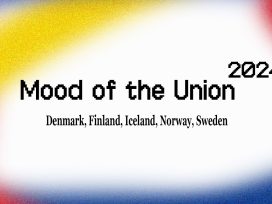American journalist Philip Gourevitch’s reportage on the Rwandan genocide, We Wish to Inform You That Tomorrow We Will be Killed With Our Families,, has probably coloured public perceptions of the Rwandan tragedy to a greater degree than any other report; it is considered by many to be a standard work, even something of a modern classic. This is unfortunate, since Gourevitch’s account has serious shortcomings and is in many respects not a charting of the genocide at all, but a political tract in defence of people and governments who bear a heavy burden of responsibility for the catastrophic conflicts raging in Central Africa in the aftermath of the genocide.
There is no fault to be found with Gourevitch’s reproduction of distressing eyewitness accounts, nor with his often telling reflections on topics such as the schizophrenic reality of the modern media consumer. But these elements do not, as the back cover text of the Swedish edition claims, make “the brutal and incomprehensible genocide conceivable”, and Gourevitch’s rudimentary analysis takes us no further than the most schematic notion of how to stage a genocide: evil leaders and sheeplike subjects.
The genocide of the Rwandan Tutsis, Gourevitch claims, was “the product of order, authoritarianism, decades of modern political theorizing and indoctrination, and of one of the most meticulously administered states in history”. This clichéd image, which could not be applied even to the Third Reich, is as banal as it is misleading. Gourevitch’s characterization can be understood as a reaction against the earliest accounts of the genocide, which saw it quite simply as an outburst of uninhibited tribal violence. But Gourevitch’s thesis of complete order is no less lazy, and treats important facts as mere details. For example: the genocide occurred in parallel with a bloody civil war, which over the preceding three years had put a large part of the Rwandan population to flight; it was triggered by the murder of the Rwandan president Juvénal Habyarimana, which unleashed panic in an already confused political situation; the genocide took place against the background of an ongoing power struggle between several elite groups, and the first to be killed by extremists following the murder of the President were not Tutsis but Hutu members of parliament, among them the Prime Minister. In short, the genocide was enacted in a climate of great fear and political bewilderment.
A few lines later, Gourevitch’s account turns distinctly vulgar: “Killing Tutsis was a political tradition in postcolonial Rwanda; it brought people together.” It is hard to see how flippant generalizations of this kind can be perceived as a penetrating explanation of the social and psychological mechanisms which turned even civilians into murderers, or as a dignified way of describing the victims’ deaths. What is more, the claim is incorrect, and sufficient in itself to cast doubt on the author’s competence.
Can stating the fact that the genocide occurred during a military and political crisis in any way mitigate the guilt of those who brought it about? Not at all. The more we understand about the circumstances that made the genocide possible, the better we also appreciate how those with ultimate responsibility exploited and manipulated the situation. When and how was a plan to wipe out the Tutsi population formulated (in contrast to plans and preparations for the systematic elimination of political opponents)? One potential answer is provided by the sociologist Michael Mann, in his acclaimed study of genocide, The Dark Side of Democracy: Explaining Ethnic Cleansing:
What […] probably happened was that as the regime lost cohesion and then its presidential head, and as it suffered a coup and was then rebuilt, it experienced a radicalization that few had anticipated beforehand, but that was also paralleled by a radicalization of sentiments among ordinary Hutus. Genocide was then improvised by radical elites and militants out of opportunity and threat. It was not long nourished as Plan A.
This theory would presumably appear suspect to the majority of Gourevitch’s readers, but René Lemarchand, one of the world’s foremost experts on the Rwandan genocide, calls it “largely convincing”. (It may be worth pointing out that long-term planning is not a criterion for holding guilty parties to account, according to the Genocide Convention). Research is in progress on many other difficult but important issues: How could individuals from different social strata be induced to participate in the genocide, and how many took part? (the “entire Hutu population”, according to Gourevitch). What was the actual chain of command on the ground during the genocide, as opposed to the official one? What regional differences were there in how the killing was organized and the way it spread? What was the effect of shifts in the frontline of the war on the scale of the killing?
No one can expect Philip Gourevitch to be able to answer these and other questions, but the lack of interest he displays in them creates a false impression that all we need to know about the genocide is already evident and established beyond doubt. Gourevitch’s model is entirely deterministic: the leadership of a totalitarian state, obsessed by racial fanaticism, plans a full-scale genocide, and carries it out with the enthusiastic assistance of those under its rule. Any complexities are glossed over with an assertion that the genocidal perpetrators’ plan “had been ingeniously designed to look planless”.
Judging by the numerous reviews of Gourevitch’s book in the Swedish press, it succeeds admirably in conveying this simplistic picture. Anders Ehnmark writes in Expressen, for example: “The scene is one of calm, according to the many witness statements that were collected. […] We can follow how the perception of a predetermined course of events, whichever side it is viewed from, creates composure and docility, a peaceful working environment for murderers, you might say.” It would be deplorable for the Rwandan genocide to be preserved in world memory in this version. The Rwandan genocide was no more predetermined than any other. There are of course grounds for reflecting on the banality of evil in Rwanda’s case, too, and on the alacrity displayed by many of the Hutus who participated in the killing, but if the tragedy continues to be discussed simply as a story of blind evil, then I fear it will not be long before we see a Rwandan Inglourious Basterds.
The flaws in Gourevitch’s book, outlined above, all spring from the author’s unconditional sympathy for one of the warring parties in Rwanda’s civil war: the rebel movement known as the Rwandan Patriotic Front (RPF), which assumed power after the genocide. Large sections of We Wish to Inform You (and the articles that preceded the book) consist of quotations from conversations with members of the RPF leadership, particularly General Paul Kagame, now President of Rwanda. It is no exaggeration to say that Gourevitch presents the civil war, the genocide and their consequences from an RPF point of view.
There are many public misconceptions about the RPF, and about the civil war. An article in the Swedish national daily Dagens Nyheter (12 July 2009) referred to a “civil war following in the footsteps of the genocide”. (Worryingly enough, Sweden’s Ministry of Foreign Affairs is cited as the source of this information.) The civil war actually began in October 1990, when the RPF carried out its first attack on Rwanda. The RPF was an international movement aiming to help those Tutsis who had been living in exile since 1959 (and their children) to return to Rwanda. The military arm of this movement consisted initially mainly of Rwandans who were part of the Ugandan army, many of them with the rank of officer; amongst these was Paul Kagame, who was the head of the Ugandan army secret service.
The RPF was viewed by many as the liberator of Rwanda when it took the capital Kigali, and reports of massacres committed by the RPF were suppressed by the international community, partly out of fear that the civil war would flare up again if another power vacuum arose, partly because the RPF had managed to present itself as a disciplined, modern army and respecter of human rights in the course of the civil war. Many journalists and experts who initially had great confidence in the RPF later found themselves obliged, more or less reluctantly, to change their views, as they could no longer shut their eyes to the RPF’s systematic outrages (Alison Des Forges and Colette Braekman are two examples). But Philip Gourevitch’s admiration for Paul Kagame and his government remains undiminished. In a recent article in The New Yorker (4 May 2009), he calls Kagame “one of the most formidable political figures of our age”.
Coverage of Rwanda since the genocide has been distinctly odd. On one hand, the story of a country that rose from the ashes and built a model democracy free from all ethnic tensions has become a sub-genre in its own right as far as reporting from Africa is concerned, not least in Sweden. On the other hand, a mountain of evidence detailing the Rwandan government’s repression and criminality confronts us if we have the stomach to look through reports from Amnesty, Human Rights Watch, Reporters Sans Frontières (Kagame features on their list of “Predators of Press Freedom”), the UN and numerous other organizations. There was a flurry of interest in winter 2008 in the fact that Rwanda is heavily involved in armed violence and plunder of mineral resources in eastern Congo, but that fact has been well known for over a decade.
Gourevitch devotes a great deal of space in We Wish to Inform You to absolving Kagame’s regime from crimes of which it has been, or could be, accused. He gives thirty pages to the infamous Kibeho massacre, in which RPF soldiers killed several thousand Hutus during the closure of a refugee camp, only to round it off with Kagame’s assertion that it was actually the RPF who prevented the massacre becoming much worse. This exercise is supposed to leave the reader feeling that the author has subjected all parties in the conflict to critical scrutiny – yet he fails to reveal to us that the Kibeho massacre was not a unique event. A group of investigators sent out by UNHCR directly after the RPF assumed power in Rwanda collected evidence that the RPF had killed between 25,000 and 45,000 people in the period from April to August 1994. Many RPF defectors have also given evidence in a variety of contexts (such as the UN’s Rwanda tribunal) about the RPF’s massacres before, during and after the genocide.
Gourevitch has shown no willingness, either in his book or in later articles, to pay any heed to these findings. He always seems to take Kagame and his men at their word, thus making their voice the voice of the book. He also allows himself to doubt the genuine intentions of ordinary Rwandans – Tutsis and Hutus – who ask for anonymity when they speak of their fear of the “foreign” Tutsis who have taken over in Rwanda. “The recipient of such confidences must try to discern the calculation behind the request”, he writes.
Most offensive of all is Gourevitch’s carefully laid out defence of the new Rwandan government’s slaughter of hundreds of thousands of Hutu refugees in eastern Congo in 1996 and 1997. He refers repeatedly to the life of luxury lived by the refugees in their camps (when they were not busy dying of cholera) and maintains emphatically that the only reason they refused to return to Rwanda, and later fled for their lives into the jungle, was violent threats from Hutu extremists in the camps. None of those who survived the long manhunt in the Congo will find their version of events related in Gourevitch’s magnum opus.
The 1996 military campaign in the Congo, which also encompassed regime change in the country (then called Zaire), was supported directly by the Clinton administration and indirectly (via Uganda) by Great Britain. This was neither the first nor the last time Gourevitch’s position appeared to harmonize with the activities of the American State Department, and the unanimity was no coincidence. Howard French, the New York Times correspondent in Western and Central Africa in the mid-1990s, documented among other things the Hutu refugees’ desperate flight, which he covered in a long and painful reportage. In his book A Continent for the Taking, he reveals that James Rubin, assistant secretary of state for public affairs and chief spokesman for the state department under Madeleine Albright at the time, told him that the department’s foremost source of information on Central Africa was “my sister’s boyfriend, Philip Gourevitch”.
When I contacted French to enquire how much truth there was in this story, he replied as follows: “This question requires no speculation. James Rubin told me face to face and in no uncertain fashion that the Clinton Administration’s take on Central Africa was substantially driven by the thinking of Philip Gourevitch. [US] Africa policy is determined in a relative vacuum, with a small number of people who care deeply or who have strong institutional backing carrying the day on most matters of policy. There is very little discussion and trendiness, superficiality or simply doing what comes easiest often prevails. Gourevitch is Kagame’s hagiographer and was never able or willing to achieve sufficient distance from his subject to arrive at anything remotely approaching objectivity. Because it was an obscure African conflict the prestige of this seemingly informed Westerner made his take on Rwanda and Congo extraordinarily influential – almost to the exclusion of other points of view.”
We Wish to Inform You is a fascinating book, but not a reliable one. On the contrary, it has done great damage with its flattering descriptions of a regime that has been instrumental in creating devastation in Central Africa. It is high time for the Swedish debate to free itself from its paranoid fear that all Rwandans critical of their government are genocide deniers (as the leadership of the RPF would have us believe). Sweden has forged strong diplomatic and economic ties with the Kigali regime, and it behoves us also to listen to voices other than those of the RPF power elite and their mouthpiece, Philip Gourevitch.






